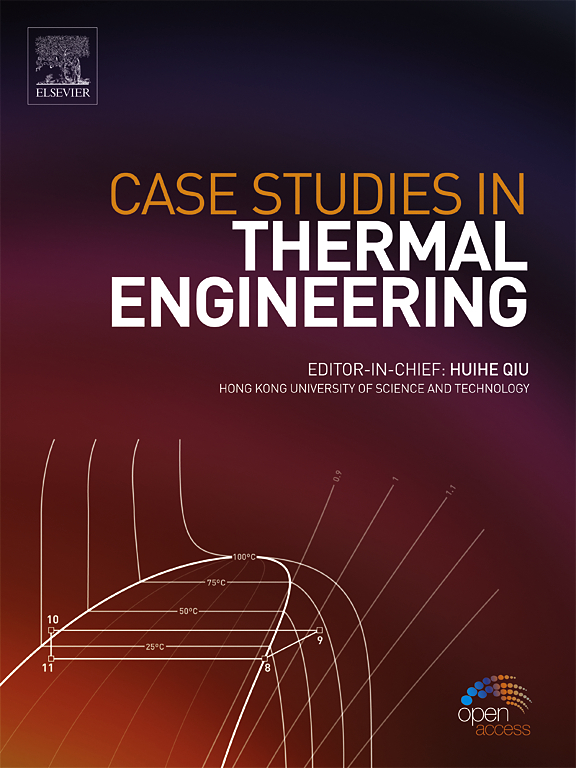Experimental study on physico-mechanical responses and energy characteristics of granite under high temperature and hydro-mechanical coupling
IF 6.4
2区 工程技术
Q1 THERMODYNAMICS
引用次数: 0
Abstract
Thermal and hydro-mechanical coupling effects on granite's physico-mechanical responses and energy characteristics can influence its carrying capacity, hydraulic and heat transfer performance. The evolution of these properties is crucial for geothermal reservoir stability assessment and the optimization of deep geothermal energy development techniques. Hence, a variety of physical tests and rock mechanics experiments were conducted. Key findings include: (1) As temperature rises, granite undergoes thermal expansion and structural integrity degradation. The peak strength σp, elastic modulus E, total energy density U, and elastic energy density Ue initially rise at 25 °C–150 °C and subsequently decrease above 150 °C, while the proportion of dissipated energy ηd is opposite. Granite also initially experiences hardening, then turns to brittle-ductile transition. (2) The crystallinities of quartz, albite, and orthoclase demonstrate substantial deterioration beyond 450 °C. (3) 150 °C and 450 °C are regarded as the temperature thresholds for mechanical properties. (4) As confining pressure rises, granite experiences hardening, with σp, E, U, and Ue increasing, and ηd decreasing. (5) Pore water pressure increases ηd and decreases σp, E, U, and Ue, and its effect on the mechanical responses is pronounced when it reaches 80 % of confining pressure or exceeds 450 °C.
高温和水力机械耦合条件下花岗岩的物理机械响应和能量特性实验研究
热和水文机械耦合效应对花岗岩的物理机械响应和能量特征会影响其承载能力、水力和传热性能。这些特性的演变对于地热储层稳定性评估和深层地热能开发技术的优化至关重要。因此,我们进行了各种物理测试和岩石力学实验。主要发现包括(1) 随着温度的升高,花岗岩会发生热膨胀和结构完整性退化。峰值强度 σp、弹性模量 E、总能量密度 U 和弹性能量密度 Ue 最初在 25 ℃-150 ℃ 时上升,超过 150 ℃ 后下降,而耗散能量比例 ηd 则相反。花岗岩最初也经历了硬化,然后转为脆-韧性转变。(2) 石英、白云石和正长石的结晶度在 450 °C以上出现大幅恶化。(3) 150 °C和450 °C被认为是机械特性的温度临界点。(4) 随着封闭压力的升高,花岗岩发生硬化,σp、E、U 和 Ue 增加,ηd 减少。(5) 孔隙水压力会增加 ηd,降低 σp、E、U 和 Ue,当孔隙水压力达到密闭压力的 80% 或超过 450 °C 时,其对力学响应的影响会非常明显。
本文章由计算机程序翻译,如有差异,请以英文原文为准。
求助全文
约1分钟内获得全文
求助全文
来源期刊

Case Studies in Thermal Engineering
Chemical Engineering-Fluid Flow and Transfer Processes
CiteScore
8.60
自引率
11.80%
发文量
812
审稿时长
76 days
期刊介绍:
Case Studies in Thermal Engineering provides a forum for the rapid publication of short, structured Case Studies in Thermal Engineering and related Short Communications. It provides an essential compendium of case studies for researchers and practitioners in the field of thermal engineering and others who are interested in aspects of thermal engineering cases that could affect other engineering processes. The journal not only publishes new and novel case studies, but also provides a forum for the publication of high quality descriptions of classic thermal engineering problems. The scope of the journal includes case studies of thermal engineering problems in components, devices and systems using existing experimental and numerical techniques in the areas of mechanical, aerospace, chemical, medical, thermal management for electronics, heat exchangers, regeneration, solar thermal energy, thermal storage, building energy conservation, and power generation. Case studies of thermal problems in other areas will also be considered.
 求助内容:
求助内容: 应助结果提醒方式:
应助结果提醒方式:


